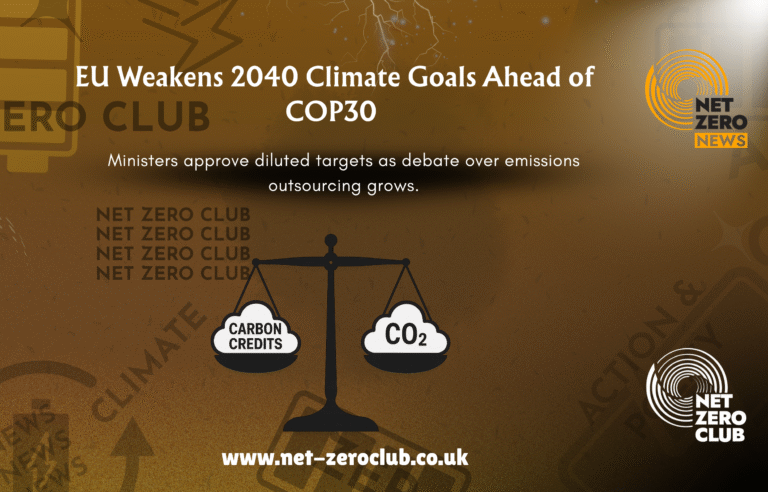UK Foreign Aid for Nature Reaches £800M Record – Cash for Carbon

Welcome, Net Zero News readers,
In an encouraging development for environmental advocates and climate-conscious citizens alike, the UK’s climate-aid spending on nature protection and restoration has surged to remarkable heights, reaching nearly £800 million last year. This impressive figure, revealed through government data obtained by Carbon Brief, signals a strong commitment from the UK government to tackle the pressing issue of climate change and its impact on biodiversity.
The latest figures suggest that the UK is well on its way to fulfilling its ambitious pledge of providing £3 billion in nature-related funds to developing countries by the year 2026. Such funding is crucial for supporting regions that are grappling with the devastating effects of climate change, and the latest data indicates a significant increase in resources allocated specifically for forest protection. However, to meet the target of £1.5 billion allocated for forest-related projects within this broader commitment, an additional £100 million will be necessary this year.
These figures, released following freedom-of-information (FOI) requests, encompass vital climate-aid contributions targeting forest-dense areas across the globe, from the Amazon rainforest to the Congo Basin. The statistics reveal that nearly half of last year’s forest funding—an impressive £153.9 million—was directed towards a controversial carbon-offsetting initiative aimed at supporting developing countries in reducing their carbon emissions. This project, titled “Scaling Climate Action by Lowering Emissions” (SCALE), marks one of the UK’s largest contributions to a nature and forests project since 2021, surpassing other long-standing initiatives.
The UK government has committed to providing a staggering £11.6 billion in climate finance over a five-year period ending in 2026, contributing to the global effort outlined in the Paris Agreement to assist developing nations in combatting climate change. As part of this commitment, the previous government pledged in 2021 that £3 billion would be allocated to projects aimed at protecting and restoring nature, with a specific focus on forest-related initiatives amounting to £1.5 billion.
Last year, the newly elected Labour government assured the public that it would uphold these targets, alongside the broader £11.6 billion climate finance goal it inherited. However, the UK, like many other developed nations, has faced significant cuts to its aid budget in recent years, placing pressure on climate-focused spending. Yet, analysis from Carbon Brief suggests that the UK is poised to meet its £11.6 billion climate-finance target, aided by accounting adjustments that permit the government to include additional forms of finance in its calculations without making substantial new financial commitments.
The data reveals that UK spending on nature-related programmes reached an impressive £796.6 million in the financial year 2024-2025, bringing the cumulative total to £2.3 billion. This figure indicates that a further £684.8 million will need to be allocated to such projects in the 2025-2026 financial year to meet the target. The projects covered under the nature target include initiatives addressing water insecurity and pollution in Nepal, support for climate-smart agriculture in African nations, and efforts aimed at achieving the global objective of protecting 30% of the Earth’s land and sea for nature.
Turning our attention to the forest-finance target, which specifically addresses deforestation and forest restoration, spending reached £341.6 million in 2024-2025, bringing the cumulative figure to just over £1 billion since 2021. To meet the £1.5 billion goal, forest aid spending will need to increase by over £100 million to reach £466 million in 2025-2026—a substantial uplift, yet not unanticipated as the government’s climate-finance targets were intentionally designed to be backloaded, with greater expenditures planned towards the latter part of the five-year period.
It is important to note that UK aid spending is projected to decline sharply again in 2026-2027, beyond the timeframe of the current climate-finance goals. Although the government has pledged to continue prioritising climate projects, unpublished analyses from the Center for Global Development (CGD) suggest that the departments responsible for financing these initiatives are facing significant budget cuts. The Department for Energy Security and Net Zero (DESNZ) and the Department for Environment, Food and Rural Affairs (Defra) provided nearly half of all nature finance in 2024-2025, yet are expected to see their aid spending drop by 59% and 45%, respectively, by 2026-2027—this decline surpassing the overall aid budget reductions.
In addition to the climate-finance targets, the UK has obligations to deliver biodiversity finance under the UN’s Kunming-Montreal Global Biodiversity Framework (GBF). However, the government has stated that it has not recorded project-level biodiversity-focused spending over the five-year period associated with its climate-finance targets. Nonetheless, the £3 billion nature target is cited in the national biodiversity strategy and action plan (NBSAP), illustrating the UK’s efforts to address the global biodiversity finance gap by counting this funding as both climate and biodiversity finance.
Among the various initiatives, the largest portion of UK nature and forest spending last year was attributed to the £153.9 million allocated to the SCALE project. This World Bank-backed programme funds ventures that generate “high-integrity carbon credits” while providing technical assistance for developing countries to engage in carbon trading. The carbon credits are generated through projects aimed at reducing carbon dioxide (CO2) emissions via forest preservation and ecosystem restoration, which can then be purchased by companies or state actors to assist in meeting their climate targets while continuing to produce emissions.
When combined with a smaller associated programme, EnABLE, which is designed to ensure local communities benefit from carbon trading, the SCALE initiative accounted for a significant one-fifth of the overall nature finance and an astonishing 45% of forest funding in 2024-2025. Despite the UK government counting 100% of the SCALE funding as forest-related, there is acknowledgement that it “may benefit various ecosystems, not just forests.”
Other notable recipients of UK support last year included the Brazilian Amazon Fund, which received £28.5 million. Carbon-offsetting is viewed by many as a critical mechanism for attracting external investment in nature protection, particularly for nations in the Global South that are home to dense forests. However, the practice has not been without its controversies, which range from the displacement of Indigenous communities to accusations of corporations exaggerating the extent of their forest protection efforts and the actual emissions reductions achieved.
Sarah Colenbrander, the director of the climate and sustainability programme at the Overseas Development Institute (ODI), has voiced concerns about the potential risks associated with nature-based carbon offsets. She notes, “The risks to nature-based carbon offsets are well-documented. Carbon and biodiversity markets can play a role in addressing climate change and nature loss, but it is not evident that the UK should allocate such sizeable grants to this topic when there are more proven, cost-effective options available to reduce emissions and protect the environment.”
The single payment of £153.9 million means that SCALE and EnABLE have received more funding from the UK government than virtually any other nature projects since 2021. The only larger recipients overall have been multilateral funds such as the Green Climate Fund (GCF) and the Global Environment Facility (GEF), which are generally well-regarded by developing countries. The UK contributed £90.8 million to the GCF and £64.8 million to the GEF last year.
When questioned about the funding allocated to SCALE and EnABLE, a government spokesperson underscored the importance of addressing “the existential climate crisis.” The spokesperson stated, “This includes putting Britain back in the business of climate leadership by supporting the reform of the global financial system and mobilising private finance for nature and to help developing countries accelerate the energy transition. This effort is complemented by collaboration with other nations and the EU in the forests and climate leaders’ partnership to drive progress towards halting and reversing forest loss.”
Among the other top projects funded by the UK, some have a clear emphasis on nature conservation, such as the Darwin Initiative, which received £27.8 million in 2024-2025. This initiative serves as the UK’s premier international challenge fund for biodiversity conservation and poverty reduction. In contrast, there are projects like the Ethiopia Crises 2 Resilience initiative, which garnered £24.9 million last year. Although its primary focus is on humanitarian relief from conflict and drought, its annual review highlights “land treated through area enclosures, rangeland management, soil and water conservation, forage and forestry activities.”
In summarising the methodology behind these nature and forest climate finance figures, it is important to note that they were provided to Carbon Brief through FOI requests from the Foreign, Commonwealth and Development Office (FCDO), Defra, and DESNZ. The pathway to achieving the £1.5 billion and £3 billion targets appears more attainable than it did in previous analyses of nature and forest data, as the final figures released by the government for the 2023-2024 financial year are notably higher than those reported last year.
Unlike other departments, the FCDO declined to provide its 2023-2024 figures last year, prompting Carbon Brief to estimate those figures based on provisional datasets for climate-finance projects. This estimation resulted in an undercount, primarily because larger-than-expected contributions to multilateral funds and banks were classified as nature-related. However, this year’s FOI responses have provided most of the government’s final figures, suggesting they are unlikely to change. For 2024-2025, only Defra—responsible for 17% of nature finance that year—provided provisional figures.
As we move forward, the importance of secure and sustained investment in climate and biodiversity initiatives cannot be overstated. The UK’s recent financial commitments represent a significant step in addressing the dual crises of climate change and biodiversity loss. Yet, as we continue to navigate the complexities of environmental finance, it is crucial that we remain vigilant and ensure that funds are allocated effectively and transparently to projects that deliver real, measurable benefits for both people and the planet.
Stay tuned for more updates and insights as we continue to monitor the evolving landscape of climate finance and the UK’s role in global efforts to combat climate change.

 Got net-zero news, project updates, or product launches to share?
Got net-zero news, project updates, or product launches to share? 




